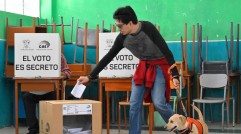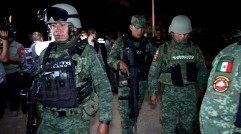Movie Review - Las Busquedas (The Searches): A Minimalist Film With Great Visceral Power
Cinema does not have to be about massive budgets. Or larger than life characters. Meager means and crude stories can be just as enriching and even gripping. These are the major principles behind Jose Luis Valle's phenomenal sophomore effort "Las Busquedas (The Searches)," and they mesh beautifully to create a film that is both riveting and beautiful to behold.
The film starts off with a mysterious man running a few errands, including giving his dog away. The viewer is not really sure what to make of it all, but a first-person shot of a long and winding road in a crowded city suggests that this character is about to go on a long journey. And that is exactly what he is set to do. Once he arrives in his polished home he sets more things in order and then walks up the stairs. The camera remains fixed on the image of the stairs and the watcher is forced to hold his/her attention on this image for what seems like an eternity, thus building suspense. Then the man descends again, this time with a gun in hand. And it all becomes clear. The camera remains fixed, leaving the viewer powerless in every possible way and with no means of actually watching the action unfold. After another lengthy wait, the gun shot goes off. Even then, there is a lack of certainty or knowledge. The viewer lacks any closure and the suspense only mounts from there. The character's wife (played by Arcelia Ramírez) shows up and finds a note addressed to her. The husband tells her that he is on the patio and did not want to leave her a mess. She walks off screen and the viewer is left waiting to hear her reaction; once again the camera remains fixed in its place and the voyeur is powerless to engage.
Right after this the second major character, a widower (Gustavo Sánchez Parra) is introduced. When the only picture of his deceased wife and child are stolen from him, he sets out on a journey to find the thief, and his life intersects with the widow from the opening sequence.
From its opening frame to its last (literally), Valle's film has no qualms about making the audience feel the intensity of his characters' feelings in real-time and creating this sense of visual longing by holding on the long takes for what often feels like eternity. When Parra's character gets robbed, the camera remains fixed on him as he takes a long subway ride from one station to the next. There are no cuts, thus highlighting the anxiety in Parra's performance and allowing the viewer to feel the length of the trip along with him. Later in the film, Parra and Ramirez's characters engage in an intimate conversation in which they make revelations about their respective pasts. The two characters stand in profile at polar ends of the frame facing one another; their rigidity is highlighted by the vertical lines of the doorway. Their motionless bodies place even greater emphasis on the intensity of their eyes. Valle's decision to stage this entire scene in one shot allows the viewer to feel the awkward pauses but also gives the audience an opportunity to interact with the characters in a more intimate manner.
The film is shot in black-and-white and reportedly cost little more than $1,500. The filmmaker apparently worked off a seven-page treatment, no shot list and no storyboards. And despite these facts, the film is impeccably photographed, and every location has a tremendous sense of congruency. Frames within frames become a prominent motif throughout the film. This is best exemplified in the woman's house, particularly her kitchen. The opening scene in which the suicidal husband goes to pick something up from a store showcases a metal bar in the middle of the frame that separates him from the lady behind the counter. Parra's character shares a dream with a friend in a kitchen; the camera shoots through a doorway, thus framing the scene within and emphasizing the rigidity and imprisoned psychological state of the characters. Even the outdoors has a dingy feel; there are no parks or even suggestions of greenery. The final sequence is arguably the most brilliant of all as it takes place in a landfill.
The silence that permeates the film only adds to this feeling of death pervading the environment and the characters' lonely lives. Dialogue picks up in later portions of the film, but even then it is measured, never really allowing the liveliness of chatter and human interaction to assert itself.
The performances are wondrous. Both Parra and Ramirez seem to walk around like zombies throughout their early interactions, thus emphasizing their internal deaths. But slowly their emotions come to the fore as they find hope in one another. Parra's performance during the train sequence is particularly striking. His increasingly agitated movement suggest a man about to explode into a rage. But his ability to repress that explosiveness only highlights the potent inner turmoil the character is experiencing.
"Las Busquedas" clocks in at under 80 minutes, but every single frame and moment is filled with tremendous detail and emotion. The film presents viewers not only with tremendous artistic conviction, but a visceral and unforgettable journey.
Subscribe to Latin Post!
Sign up for our free newsletter for the Latest coverage!














